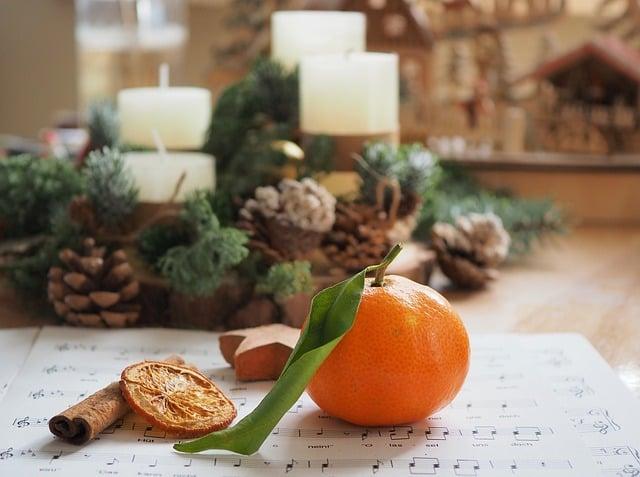In a quaint village, the townsfolk eagerly awaited the arrival of winter. As December approached, they adorned their homes with twinkling lights and fragrant pine. But first came Advent, a time of reflection and anticipation. Each Sunday, they lit a candle, sharing stories of hope and joy, preparing their hearts for the miracle to come.
When Christmas finally arrived, the village erupted in celebration—carols filled the air, and laughter echoed through the streets. Advent was the journey; Christmas was the joyous destination, a reminder that every ending is a new beginning.
Table of Contents
- Understanding the Liturgical Calendar: The Role of Advent and Christmas
- The Spiritual Significance: Preparing Hearts During Advent
- Celebratory Traditions: How Christmas Differs from Advent Practices
- Embracing the Seasons: Recommendations for Meaningful Observance
- Q&A

Understanding the Liturgical Calendar: The Role of Advent and Christmas
Advent marks the beginning of the liturgical year, a time of preparation and anticipation leading up to the celebration of Christmas. This season lasts for four weeks, starting on the fourth Sunday before Christmas Day. During Advent, the faithful engage in practices that foster reflection and spiritual readiness, such as lighting the Advent wreath, which symbolizes the light of Christ coming into the world. The themes of hope, peace, joy, and love are emphasized, inviting individuals to contemplate the significance of Christ’s birth and the promise of His return. **Traditions** during this period may include:
- Daily scripture readings and prayers
- Advent calendars that count down to Christmas
- Community service and acts of kindness
In contrast, Christmas is the joyous celebration of the birth of Jesus Christ, observed on December 25th. This season extends beyond a single day, traditionally lasting until the Feast of the Baptism of the Lord, which occurs in early January. Christmas is characterized by a spirit of joy and festivity, where families gather to celebrate with feasts, gift-giving, and various cultural traditions. The focus shifts from preparation to celebration, highlighting the fulfillment of the Advent promises. **Key elements** of the Christmas season include:
- Midnight Mass or Christmas services
- Nativity scenes depicting the birth of Jesus
- Caroling and festive decorations

The Spiritual Significance: Preparing Hearts During Advent
As the season of Advent unfolds, it invites us into a sacred space of reflection and anticipation. This period, distinct from the joyous celebration of Christmas, serves as a spiritual preparation for the coming of Christ. It is a time to cultivate a deeper awareness of our hearts and minds, allowing us to embrace the themes of hope, peace, joy, and love. During these four weeks, we are encouraged to engage in practices that foster spiritual growth, such as:
- Prayer and Meditation: Setting aside time for quiet contemplation helps us to listen for the divine in our lives.
- Acts of Kindness: Engaging in charitable acts reminds us of the importance of community and compassion.
- Scripture Reading: Delving into biblical texts related to the Advent season deepens our understanding of the significance of Christ’s coming.
- Advent Wreath Traditions: Lighting candles each week symbolizes the growing light of Christ in our lives.
In this sacred time, we are called to prepare our hearts, not just for the festivities of Christmas, but for a transformative encounter with the divine. Advent encourages us to reflect on our spiritual journeys, to recognize the areas in our lives that may need healing or renewal. By embracing this season of waiting and preparation, we open ourselves to the profound mystery of God’s love, allowing it to illuminate our paths and guide us toward a more meaningful celebration of Christmas. This intentional focus on preparation enriches our experience, reminding us that the true essence of the season lies in the journey of the heart.

Celebratory Traditions: How Christmas Differs from Advent Practices
As the festive season approaches, the distinction between Advent and Christmas becomes increasingly significant. Advent, a period of anticipation and preparation, typically spans the four weeks leading up to Christmas Day. It is marked by a spirit of reflection and hope, inviting individuals to engage in practices that deepen their faith and understanding of the coming celebration. Common traditions during Advent include:
- Advent Wreaths: Circular arrangements of greenery with four candles, one for each week, symbolizing the light of Christ entering the world.
- Daily Devotions: Special readings or prayers that guide individuals through the themes of hope, peace, joy, and love.
- Advent Calendars: Countdown calendars that reveal a small gift or scripture each day, building excitement for Christmas.
In contrast, Christmas is a jubilant celebration that marks the birth of Jesus Christ, filled with joy and festivity. This season is characterized by a variety of customs that emphasize community, generosity, and merriment. Families and friends come together to partake in traditions such as:
- Gift-Giving: A practice that symbolizes the gifts brought to Jesus by the Magi, fostering a spirit of generosity.
- Feasting: Elaborate meals and gatherings that celebrate the season, often featuring traditional dishes unique to different cultures.
- Caroling: Singing festive songs that spread cheer and share the Christmas message with others.

Embracing the Seasons: Recommendations for Meaningful Observance
As the calendar turns and the days grow shorter, the transition from Advent to Christmas invites us to engage deeply with the rhythms of the season. **Advent**, a time of anticipation and reflection, encourages us to slow down and prepare our hearts for the joy of Christmas. To embrace this season meaningfully, consider creating a personal Advent calendar filled with daily reflections, prayers, or acts of kindness. This practice not only builds excitement but also fosters a spirit of gratitude and mindfulness. Additionally, lighting a candle each week can symbolize the growing light of hope, peace, joy, and love, allowing you to connect with the essence of the season.
As Christmas approaches, the focus shifts from preparation to celebration. This is the time to gather with loved ones and share in the joy of the holiday. **Meaningful observance** during this period can take many forms, such as:
- Hosting a festive meal that highlights traditional dishes from your culture.
- Participating in community service or charitable giving to help those in need.
- Creating a family tradition, like decorating a tree together or watching a favorite holiday movie.
- Engaging in storytelling, sharing the significance of Christmas and its traditions with younger generations.
By intertwining these practices, you can cultivate a rich tapestry of experiences that honor both the reflective nature of Advent and the joyous celebration of Christmas.
Q&A
-
What is Advent?
Advent is a season of preparation and anticipation leading up to Christmas. It typically begins on the fourth Sunday before Christmas and lasts until Christmas Eve. This period is marked by reflection, prayer, and the lighting of Advent candles.
-
What is Christmas?
Christmas is a celebration of the birth of Jesus Christ, observed on December 25th. It is a festive occasion characterized by joy, gift-giving, and various cultural traditions, marking the culmination of the Advent season.
-
How do the themes of Advent and Christmas differ?
Advent focuses on themes of hope, waiting, and preparation for the coming of Christ, while Christmas celebrates the fulfillment of that hope with joy and festivity. Advent is a time of reflection, whereas Christmas is a time of celebration.
-
Are Advent and Christmas celebrated the same way?
No, they are celebrated differently. Advent often includes practices like lighting candles, daily devotionals, and calendars, while Christmas involves festive gatherings, decorations, and the exchange of gifts. Each has its own unique customs and significance.
In essence, Advent and Christmas serve as two distinct yet intertwined chapters in the holiday narrative. While Advent invites reflection and anticipation, Christmas celebrates the joyous culmination of that journey. Embrace both seasons for a richer experience.

大家好,我是彼得潘,專業的手法身體治療師。我喜歡探索和研究各種主題,並透過與人工智慧的合作分享專業、實用、有趣的文章。我們定期進行人工審核,以確保內容的準確性。如果您發現文章中有任何不準確的地方,請隨時與我們聯繫,我們會及時糾正。您可以透過 [email protected] 與我們聯繫。



